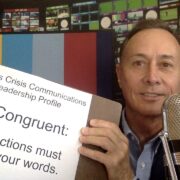What Does a Crisis Communications Drill Need to Test?
 By Gerard Braud
By Gerard Braud
Prepare for your crisis on a clear sunny day. Your darkest day is the worst day to deal with a crisis.
So, how do you do that? With a Crisis Communications Drill.
A Crisis Communications Drill can simulate realistic emotions and pressures in a controlled environment, where you can mess up in private, rather than messing up during a real crisis.
Your goal in every Crisis Communications Drill should be to test multiple aspects of the organization. These are the seven most important things I test in the drills for my clients:
1) Is there a properly written Crisis Communications Plan that is so thorough that it can be read during the drill, word-for-word, in real time? Does it ultimately result in flawless performance by the Crisis Communications Team?
2) Did that Crisis Communications Plan allow the organization to begin issuing news releases, postings to the web, texts, and e-mails to employees within one hour or less of the onset of the crisis?
3) Did executives within the organization slow down the communications process by excessively word-smithing news releases?
4) Did the Crisis Communications Plan have pre-written news releases that were pre-approved on a clear sunny day by the executive team, so they could be released quickly without re-writes?
5) Are their multiple spokespeople who are qualified to stand before my mock media and survive their questioning?
6) Did misguided egotists step out of their assigned roles and try to take over other people’s jobs? Did they withhold information that kept others from properly doing their jobs, thereby compromising the organization in its crisis response?
7) Did the drill create enough realistic drama and anxiety, to add a level of fear into all participating teams? Did it help them realize drills and media training must be treated like an athlete treats their sport? Did it help them understand that regular practice on a clear sunny day makes you your best on your worst day?
If your drill covers all of these bases, you are on your way towards effective crisis communications. You are not done, however, because crisis drills must be practiced multiple times throughout the year.
Crisis communications and media training expert Gerard Braud, CSP, Fellow IEC is based in New Orleans. Organizations on five continents have relied on him to write their crisis communications plans and to train their spokespeople. He is the author of “Don’t Talk to the Media Until…”
More crisis communications articles:
3 Lessons the Melania Trump Coat Can Teach All Public Relations People
The Biggest Lie in Crisis Communications
4 Steps Every Company Needs to Take in Order to Avoid the Default Spokesperson





Leave a Reply
Want to join the discussion?Feel free to contribute!